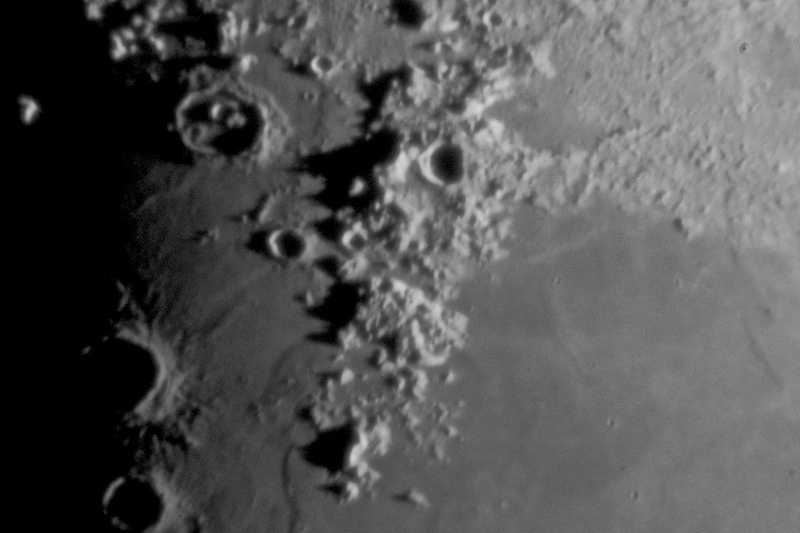
Moon Imaging: Crater Albategnius & Montes Caucasus
Posted: 26 July 2012
Monsoon storms took a break on Wednesday, 25 July 2012, and I was able to finally open the observatory again after a week of no observing due to clouds and storms. The observatory was opened at 1859 MST, temperature 97°F. The sky was mostly clear but there were some clouds around, as seen in this photo taken at sunset (1928 MST), Nikon D7000 DSLR, f/6.3, 1/320sec, 110mm, ISO 500:

At 1910 MST, took a quick look at Saturn, 77X, and then the moon, 77X and 133X. There were some great shadows along the lunar terminator. I selected the crater Albategnius and Montes Caucasus for high magnification imaging targets. I then switched from the star diagonal to the visual back and mounted the D7000 DSLR at prime focus. Took this image at 1937 MST, 1/320sec, ISO 500:

As I was imaging the moon, the clouds were increasing. This is the Crater Albategnius, eyepiece projection (222X), "Hat Trick", ISO 500, cropped from the full-frame image:

And Montes Caucasus, eyepiece projection (222X), "Hat Trick", ISO 500, cropped:

I ended imaging with the 8" LX200-ACF at 2002 MST. At 2018 MST, I captured this view of the moon, Saturn (top), Spica (beneath Saturn), and Mars (upper right) with the D7000 DSLR, 70mm, ISO 500:

The planets and Spica were captured at f/4.5, 1/30sec. The moon overexposed in that photograph, so I took a photograph at f/8, 1/160sec, and merged its moon image onto the other photograph, resulting in the image above.
At 2022 MST, I began doing some lunar observing at 206X and 364X. Although seeing was not very good due to the clouds, there were some great views along the terminator. The lunar limb also showed nice views in places.
At 2030 MST, viewed Saturn, 206X. Titan and two other moons were visible. I then decided to end this session due to the clouds, bright moon, and an early morning appointment. Monsoon storms are forecast to return for the next several days (and nights).
Closed the observatory at 2056 MST, 80°F.
Comments are welcome; use the Comments section below, or you can Email Me. Thanks.
Go to the previous report.
Return to the Cassiopeia Observatory Welcome Page.